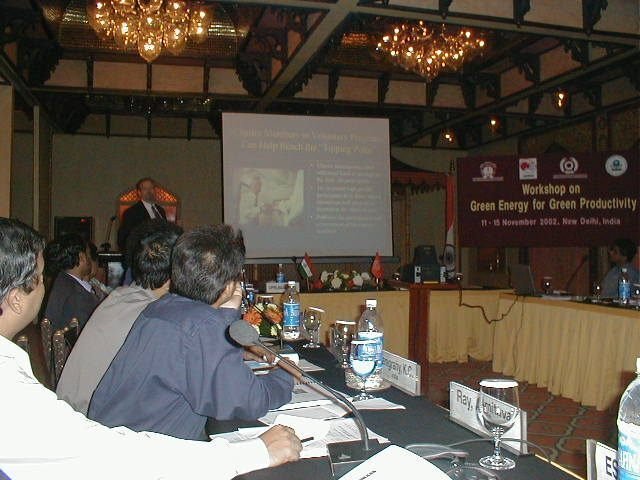
省エネ大賞受賞技術開発の軌跡 (23) Trajectory of Energy Conservation Grand Prize-winning Technology Development (23)
1.4・4 石炭、石油、原子力、新エネルギー (1)
私は2002年11月にインドのニューデリーで開催されたエネルギーワークショップに参加する機会をいただきました。
アジア18カ国、約40名が11月11日から15日の5日間このエネルギー関係の国際会議・ワークショップで情報交換し討議しました。この目的は新エネルギー、省エネルギーと生産性をどのように両立させるかでした。日本からは民間人として私と(財)社会生産性本部の児美川氏の2名そして主催団体としてのアジア生産性機構(APO、国際機関)事務局の日本人スタッフの方2名が出席しました。この国際会議・ワークショップはアメリカ環境保護局(USEPA)とアジア生産性機構(APO)の共催でした。
この種のエネルギー関連のアジア諸国国際会議への私の出席は前年2001年の台北での会議(APO主催)に続いて二回目でした。会議・ワークショップの目的は討議の内容、成果をそれぞれの国々に持ち帰り新エネルギー・省エネルギー政策推進と実施のための架け橋になることでした。更に個人的に私にはこの国際会議、ワークショップで私自身の省エネルギーへのゆるぎない目標を設定すること、そして私が開発した省エネルギー技術を紹介説明することでした。
11月10日の早朝に広島県の尾道を新幹線で出発し、関空、バンコク経由で16時間ほどかけてニューデリー到着しました。初日のインドでは早く空港を後にしてホテルに入って眠ろうかと思っていましたが、空港で荷物が出てこないためにアメリカ人を含む数人が呆れ顔で30分ほど余分に待たされるというハプニングがありました。また、プリペイドタクシーの運転手から私が支払った料金350ルピーの中から不法分50ルピーを取り戻しました。初めてのインドは色々あって、これもまた楽しいスタートでした。
11日からの5日間はアメリカ環境保護局(USEPA)担当者からのプレゼンテーションとインド生産性本部の担当者からのプレゼンテーションを中心とした新エネルギーと省エネルギーと生産性の問題をアジアの18カ国の人たちと一緒に聞き、論じました。(インド人の英語はなまりがありなかなかタフです。こうなりゃ、相手の言うことはわからなくても適当に聞いてはこっちの言うことを言わなきゃ損するという気持ちも必要です。)
同じアジアとはいえ、各国のエネルギー事情は大きくことなります。日本や韓国などは風力、太陽光発電などの新技術を、他の国々はバイオマス発電エネルギーに注力しています。アメリカは自分たちが作った省エネルギー基準のエネルギースターがベストと考えているようでした。他のベターな案は検討にも値しないといったようないつものアメリカ的態度に閉口しました。また、いつものようにアジア諸国に一段高いところから“教えてやる”いるような印象がぬぐえませんでした。
ニューデリーの町は大変緑が多く、その量は東京など比較になりません。また自動車への天然ガス使用も6割にも達しているそうです。これらの事実に驚くと同時に関心しました。天然ガス使用自動車が数台導入されてニュースになるような日本ではいけません。
続く

International Energy Workshop, co-sponsored by the U.S. Environmental Protection Agency (USEPA) and the Asian Productivity Organization (APO), in Delhi, India, November 2002.
1.4.4 Coal, oil, nuclear power, new energy (1)
I had the opportunity to participate in the Energy Workshop held in New Delhi, India in November 2002.
About 40 people from 18 countries in Asia exchanged information and discussed at this international energy-related conference / workshop for 5 days from November 11th to 15th. The purpose was how to balance new energy, energy saving and productivity. From Japan, two people, I and Mr. Komikawa from the Social Productivity Headquarters and two Japanese staff from the Secretariat of the Asian Productivity Organization (APO, International Organization) as the sponsoring organization attended. This international conference / workshop were co-sponsored by the US Environmental Protection Agency (USEPA) and the Asian Productivity Organization (APO).
This was my second time attending this kind of energy-related international conference in Asian countries, following the 2001 conference in Taipei (sponsored by APO). The purpose of the meeting / workshop was to bring back the content of discussions and outcomes to each country and serve as a bridge for promoting and implementing new energy / energy conservation policies. Furthermore personally, it was at this international conference / workshop that to set my own unwavering goals for energy conservation and to introduce and explain the energy conservation technologies I have developed.
I left Onomichi in Hiroshima Prefecture by Shinkansen early in the morning of November 10 and arrived in New Delhi in about 16 hours via Kansai International Airport and Bangkok. In India on the first day, I wanted to leave the airport soon and to go to the hotel to sleep, but some people including Americans were forced to wait an extra 30 minutes with a frightened face because the luggage did not come out at the airport. It was an unexpected happening. In addition, I had to get 50 rupees back from the 350 rupees I had prepaid to the taxi driver. There happened various things in my first stay in India and this start was also a fun.
From the 11th to the 5th, people from 18 countries in Asia and we discussed the issues of new energy, energy saving and productivity by the presentations from USEPA representatives and from Indian productivity headquarters representatives. (Indians' English is quite tough with dullness. In this case, even if you don't understand what the other person says, you need to say what you want to say.)
Even in the same Asia, the energy situation in each country is different. Japan and South Korea are focusing on new technologies such as wind power and solar power generation, while other countries are focusing on biomass power generation energy. The United States seemed to think that the energy star they created was the best energy saving standard. I could not feel overwhelmed the usual American attitude that other good ideas were not worth considering. Also, as usual, I again got the impression that USA was teaching to Asian countries from a higher place.
The city of New Delhi has a lot of greenery and the amount is not comparable to that of Tokyo. It is also said that the use of natural gas in automobiles has reached as much as 60%. I was surprised and interested in these facts. Japan shouldn't make it a news that several cars using natural gas have been introduced.
To be continued

